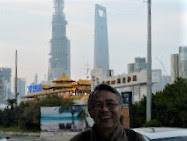Not long ago, my sister shared something surprising to me: according to our mother, our maternal grandfather had actually first gone to work in a mine in Malay before eventually coming to North Borneo (now known as Sabah) (Read here about my grandfather). My mother recalled that the mine he worked in was exceptional deep, though she couldn't recall its exact location.
When my wife heard this, she immediately suggested that the mine in question was likely the famous tin mine in Sungai Lembing.
Sungai Lembing is a historic mining town located about 40 Km northwest of Kuantan, in the state of Pahang, Peninsular Malaysia. A river runs through the town and eventually flows into the sea near Kuantan. According to the local Chinese accounts, the name "Sungai Lembing" (林明) originated from an Indonesian Chinese man, who upon discovering the area's rich tin deposits, decided to invest in mining operation there.
Until 1970, Sungai Lembing was the largest tin producer in the world and was also known for having the deepest underground mine shaft globally (Read here).
 |
| Sungai Lembing: 3054’ 46.44”N, 1030 1’ 57.94”E |
The British company Pahang Consolidated Company Limited (PCCL) was granted the rights to extract tin in 1891. Mining operations officially began in 1906 and continued until 1986, when global tin market collapsed. Tin was extracted through an extensive network of deep tunnels stretching a total of 322 Km, with shafts reaching depths of between 610 m (2,000 feet) and 700 m (2,300 feet).
In the early 20th century, PCCL went to southern China to recruit labourers, bringing in Chinese workers to work in the mines. I believe my grandfather was among those who made the journey. These early migrants likely arrived near Kuantan by sea and were then transported upriver by boat to reach the mining town of Sungai Lembing.
At its peak, PCCL employed nearly 1,500 workers and provided housings, amenities, and even a cinema for its employees.
However, my grandfather did not remain in the mine for long. Unfortunately, the reason he left Sungai Lembing for North Borneo remains a mystery.
Since the closure of the mine in 1986, Sungai Lembing has steadily declined. Today, most of those who remain are elderly residents - descendants of the early Chinese miners. The younger generations have mostly relocated to larger towns and cities in search of better opportunities.
Despite this, Sungai Lembing still draws tourists. Many come to explore its remaining century-old buildings, the long suspension bridge, ancient trees, and to savor the town's well-known local dishes and delicacies.
Recently, Astro aired a documentary about this town, and I was fortunate to capture some of the old photographs that were featured in the program.
















**************************************************
I hope to visit Sungai Lembing in the not-too-distant future - to explore its historic charms and sample some of the much-talked-about local dishes and delicacies. Who knows, I might even be fortunate enough to uncover a piece of my grandfather's story while I'm there!
**************************************************
Sungai Lembing yong tau fu. Traditionally made using fresh stream water sourced from pristine untouched jungle.

Century-old tree (百年老樹): Then and now.

Suspension Bridge.

Suspension Bridge.






































